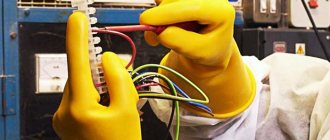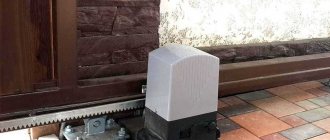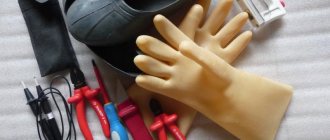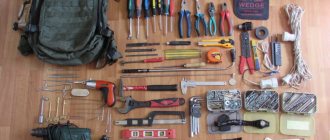In previous publications, we have repeatedly referred to protective equipment in electrical installations that provide reliable protection for electrical personnel from the destructive factors of currents. Since we have not previously delved into this issue, it’s time to talk in detail about electrical protective equipment, their specifics, classification and procedure for use. At the end of the article, we will provide some tips and recommendations that will be useful when using protective equipment in electrical installations (PPE).
Purpose and characteristics
When servicing electrical equipment connected to power, there is a danger of electric shock to electrical personnel. Moreover, the possibility of this cannot be excluded even if electrical safety standards are observed. An example is accidental contact with live structural elements when working in close proximity to them. Also, supplying voltage to the area where repair or maintenance work is being carried out can lead to tragic consequences.
Since it is not possible to completely eliminate the likelihood of such incidents, the use of personal and collective protective equipment in electrical installations is practiced. This can be dielectric clothing, insulated tools, as well as other special equipment. Their general purpose is to prevent electric shock.
The characteristics of personal protective equipment depend on the specifics of use and purpose. Let us give as an example the main parameters of latex dielectric gloves shown in the photo below.
Seamless dielectric latex gloves
List of characteristics of rubber gloves:
- The voltage class is indicated in volts, in our case up to 1000.0 V.
- Permissible leakage current is 9.0 mA (at a voltage of 10 kV).
- Strength – no less than 14 MPa.
- Operating temperature range from -40.0°C to 40.0°C.
- The minimum glove length is 350.0 mm.
- Width 130.0 - 136.0 mm.
- The minimum thickness of the rubber layer is 1.0 mm.
As you can see, the main parameters are the voltage class, operational properties and dimensions. These characteristics are also significant for other types of dielectric clothing. Naturally, measuring devices, which also belong to protective equipment (hereinafter referred to as SZ), have a significantly larger number of parameters, and these characteristics depend on both the type of product and design features.
Benefits of PPE from
We cooperate only with trusted manufacturers who have proven themselves in the market. This is why the products in our catalog are different:
- strength;
- durability;
- wear resistance;
- resistance to external influences;
- hypoallergenic;
- environmental friendliness;
- at an affordable price.
The presented sets are easy to clean, resistant to the external environment, and made of modern high-quality materials. From us you can buy PPE for a wide range of work, including highly targeted and specific ones. All products are certified and have undergone thorough safety control. Find out more from our consultants.
Classification Features
The protective equipment used in electrical installations can be individual or collective. The first are designed to protect one person. These can be dielectric boots and gloves, various types of helmets, insulating stands and mats, as well as other types of PPE. The use of collective protective equipment should include the installation of protective fences, grounding, portable posters, insulating pads, etc.
In addition, depending on the voltage class, SZ is usually divided into two types:
- For installations limited to 1 kilovolt;
- Used in high-voltage systems from 1 kilovolt.
There is another significant classification criterion based on the level of reliability. Depending on it, protective equipment is divided into two groups:
- Essentially, the level of insulation of such protective equipment can provide long-lasting protection. This makes it possible to carry out maintenance of electrical installations without turning off the power.
- Auxiliary (additional). These include means that do not guarantee an adequate level of safety when working under voltage. However, they can be used in conjunction with basic special means to enhance the insulating properties of the latter.
It is typical that the same special protective equipment, depending on operating conditions, can act as primary or additional personnel protection. Such conditions are the voltage class. For example, gloves made of dielectric rubber when servicing electrical systems with voltages up to 1 kilovolt are considered the main special means of protection, but the insulation of these products is not enough when you have to work in high-voltage closed and open electrical installations, that is, those where the voltage class is >1.0 kV . Therefore, in this case, protective gloves are considered auxiliary PPE.
Having dealt with the classification, let's look at what types of protective equipment belong to each other.
Basic protection
We have already mentioned that the voltage class is a significant factor, so we will list special equipment separately taking into account this characteristic.
Up to 1000 V
This group includes the following types of personal protective equipment:
- Operating and measuring rods. The first ones are designed to perform various tasks, ranging from replacing safety devices to switching disconnectors or installing grounding. The latter are used to check electrical connections by measuring potential level, temperature and other characteristics at the contacts. In addition, the production of universal special rods is practiced, combining the qualities of the first and second.
Universal insulating rod - Insulating pliers, they are intended for replacing fuses, removing insulating strips and other operational operations. When testing of mites and other PPE is carried out will be described separately.
Example of using insulating pliers - Electrical measuring instruments , for example, clamps for measuring current or voltage indicators (hereinafter referred to as UN). With their help, indicators are taken from current-carrying elements.
- Gloves made of dielectric material . Despite the fact that this type of protective equipment was discussed above, it is necessary to talk about them in more detail. Gloves, like other types of dielectric clothing, can only be used when dry. Before use, it is necessary to check for mechanical damage and integrity of the product. The easiest way to do this is to roll up the glove filled with air, which will reveal a puncture if there is one.
- Specialized hand tools, on which an insulating coating is applied.
Dielectric tools set
Above 1000 V
We list the isolating devices of this group:
- All types of insulating rods and tongs . Their description was given above.
- Special designs and devices, ensuring the proper level of safety when carrying out measurements in electrical installations. These include high-voltage voltage regulators, various types of electrical clamps, special tools for tingling the insulation of cable lines, etc.
High voltage voltage indicator - Special equipment for servicing electrical systems with voltage class from 110.0 kV. An example is non-contact voltage indicators.
Non-contact voltage indicator
Storing dielectric mats
Mats should be stored in dry rooms with air temperatures from 0 to +30 degrees. Products should not be exposed to direct sunlight, gasoline, oils and other aggressive substances, as well as any mechanical damage. It is prohibited to store products near heating appliances.
Storage of dielectric mats is permissible rolled into rolls, either one or several copies, or folded into bundles, excluding their deformation.
When storing products at subzero temperatures, unpacked products should rest for 24 hours at a temperature of + 20 degrees.
The guaranteed shelf life stated by the manufacturer is three years from the date of production of the product, and the service life is three years from the date of its use.
Additional electrical protective equipment
Let's move on to consider auxiliary protective equipment in electrical installations, which, like the main ones, are usually divided by voltage class. Please note that with the main means of protection in electrical installations up to 1000V, it is allowed to use only one additional means of protection, if this does not contradict production factors or technical requirements.
Up to 1000 V
Isolating devices of this group include:
- Safety shoes in the form of dielectric galoshes or rubber boots. With the help of such products it is possible to avoid exposure to electric currents connected to the ground. It is recommended to use if the floor in the work area has a conductive coating.
Dielectric bots - Insulating stands and dielectric carpets . The purpose of this PPE is the same as that of safety shoes. The use of carpets and stands is allowed in closed spaces (except for damp rooms) and in open spaces (in dry weather).
- A variety of insulating linings and caps . They physically prevent accidental switching on of the line on which technical work is being carried out.
Above 1000 V
High voltage auxiliaries include:
- Safety shoes and gloves with appropriate dielectric characteristics.
- Safety helmets, specialized suits, etc.
- Portable grounding and fencing of live parts.
It is typical that when working in high-voltage installations with basic protective equipment, several types of auxiliary personal protective equipment are used.
Requirements for electrical rooms
According to generally accepted norms and standards, electrical panel equipment must be placed in specially designated rooms. Of course, it is permissible to place some cabinets outdoors, on a support or on the outside of a building, as well as in vestibules or on floors.
For all other panels, panel rooms are provided, which are usually small in size and contain all the necessary devices for the safe and uninterrupted functioning of the building’s electrical systems. According to the established rules, several requirements are put forward to them, which should be taken into account to avoid loss of life and damage to property.
Test frequency
According to the requirements of the standards, all protective equipment in electrical installations are subject to regular verification; we are talking about high-voltage insulation tests. Below is a table indicating the testing frequency for various PPE.
Table 1. Regularity of operational tests.
| product name | Testing frequency (in months) |
| Various types of insulating rods | 24 |
| Measuring rods | 12 |
| Insulation and current clamps | 24 |
| UN, including high voltage | 12 |
| Electrical insulating gloves | 6 |
| Safety shoes (boots) | 36 |
| Safety shoes (galoshes) | 12 |
| Checking the insulation of instruments | 12 |
Procedure for using protective equipment
According to the current Rules, PPE, as inventory property, must be stored in premises designated for this purpose and issued to field teams or for individual use.
Only those protective equipment in electrical installations that have passed tests are allowed for use, and there is a corresponding entry on the product stamp.
As for the norms of distribution, they depend on internal regulations, which take into account the characteristic conditions in a particular organization. But at the same time, violations of the requirements of safety and labor protection standards are not allowed. When distributing, information about storage locations is required to be retained. For this purpose, special lists are provided, recorded with the signature of the responsible person and the seal of the organization.
If during the testing process or during an external inspection unsuitable personal protective equipment is identified, they are subject to write-off, followed by removal from the storage location. Information about this should be reflected in the protective equipment record book or operational documents, for example, when the unsuitability of personal protective equipment is discovered on the road.
Electrical personnel, after receiving PPE in hand, bears full responsibility for compliance with operating rules and must be able to independently determine their current condition, as far as possible under working conditions. In this case we are talking about external inspection for integrity.
The use of a special tool must be carried out in accordance with its purpose and in accordance with the tolerance established for the parameters of the DC or AC electrical network.
Protective equipment in electrical installations intended for enclosed spaces can be used in open spaces, but only if the weather is dry. In case of frost, rain or high humidity, it is necessary to use specialized tools designed for use in such weather conditions. A note on the relevant electrical tests must be included in the product passport.
Before starting to operate PPE, electrical personnel are required to check for any punctures in the insulation or other damage. It is mandatory to check the permissible service life and the date of the last tests. This information is contained in the stamp. It is strictly prohibited to use expired protective equipment during work!
To avoid exposure to touch voltage, do not touch the working surfaces of PPE during operation, as well as insulating parts outside the limiting stop or ring.
Requirements for dielectric carpets
According to the established state standard, dielectric mats must meet a number of requirements. If the product to some extent does not comply with GOST, then its use may lead to undesirable consequences, therefore, before purchasing dielectric carpets, you should pay attention to its compliance with the standard.
Carpets must be made of rubber, the electrical strength of which should not be less than 10 kV/mm. The strength of the rubber must also withstand bending of the product by 180 degrees in two mutually perpendicular directions, without leaving cracks or creases. The physical and mechanical properties of the rubber used in the manufacture of dielectric mats are clearly stated in the relevant GOST.
All rugs must be one color and have a corrugated surface (reef depth 1-3 mm) to prevent slipping.
There should be no foreign inclusions, holes or cracks on the front side of the dielectric carpet. The standard allows the presence of small (no more than 1 mm in depth or height, and no more than 4 mm in diameter) shells or bubbles, but no more than 6 pieces per 1 meter of product length. Also, on the front side of the rug it is acceptable to have minor flaws in the relief pattern, its underpressing or different colors.
On the back of the mat, the presence of acceptable sizes of shells (maximum 1.5 mm in depth, 35 mm in length and 20 mm in width) or bubbles (maximum 1 mm in height and 5 mm in diameter) should also not exceed the number of 6 pieces per 1 meter length of carpet.
The standard also allows the presence of traces of anti-adhesive on both sides.
The test voltage that dielectric mats must withstand is 20 kV alternating current with a frequency of 50 Hz. The maximum permissible leakage current value for mats is 160 mA/sq.m.











